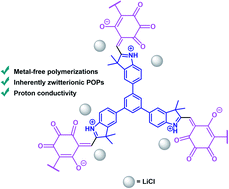Superprotonic conduction of intrinsically zwitterionic microporous polymers based on easy-to-make squaraine, croconaine and rhodizaine dyes†
Abstract
Porous organic polymers (POPs) have been prepared via a novel metal free polycondensation between a tritopic indole-based monomer and squaric, croconic and rhodizonic acids. Each of the three POPs exhibited high BET surface areas (331–667 m2 g−1) and zwitterionic structures. Impedance measurements revealed that the intrinsic POPs were relatively weak proton conductors, with a positive correlation between the density of oxo-groups and the proton conduction. Doping the materials with LiCl vastly improved the proton conductivity up to a value of 0.54 S cm−1 at 90 °C and 90% relative humidity.

- This article is part of the themed collection: Design and function of materials nanoarchitectonics


 Please wait while we load your content...
Please wait while we load your content...